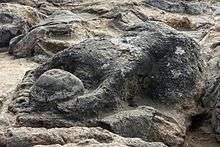Malin Kundang
Malin Kundang, Si Tanggang also called Nakhoda Manis, is a Southeast Asian folktale about retribution on an ungrateful son. A sailor from a poor family, the protagonist sneaks onto a trading ship, eventually becoming rich, marrying a princess, and acquiring his own galleon. On his return to his home village, he is ashamed of his humble origins and refuses to recognise his elderly mother. She curses him, and when he sets sail, he and his ship are turned to stone.[1]
.jpg)
Indonesia

In Indonesia, the story is called Malin Kundang, and the legend is based in West Sumatra. Air Manis, a beach near Padang, has a rock formation called Batu Malin Kundang that is said to be the remains of his ship.[2]
Another Indonesian folk story which is alike but take the different location is the legend of Sampuraga. The legend is based in Central Borneo. Belantikan Hulu, a remote area along the river Lamandau, Indonesia, has a rock formation called Bukit Sampuraga which is believed to be the ruins of his ship.
Brunei
In Brunei, the local variant of the story is called Nakhoda Manis and is associated with a prow-like rock, Jong Batu, in the Brunei River.[3]
Malaysia and Singapore
In Malaysia and Singapore, the story is known as Si Tenggang or Si Tanggang’’[4] One particularly unique Malaysian variant is Cerita Megat Sajobang in which the main character, Tenggang or Tanggang, is an orang asli (tribal aborigine) who assimilates himself into Malay society and refuses to receive his loincloth-wearing parents.[5][6]
Modern popular culture
As a parable on family responsibility, the story is popular in Southeast Asia as a theme for animations, film, drama and literature even until today. For example:
- a black and white Malay movie was produced in 1961;[7]
- the 1979 autobiographical The Travel Journals of Si Tenggang II, one of the major poetical collections of the Malaysian laureate Muhammad Haji Salleh, uses the story as a metaphor for the general experience of moving away from one's cultural roots,[8] and;
- a 2009 Malaysian documentary chronicling the origins of the legend produced by Astro.[9]
See also
References
- Many Flowers: Primary Student Materials, Warren Brewer, Curriculum Corporation (Australia), 1995
- Vaisutis, Justine (2007). Indonesia. Lonely Planet. ISBN 9781741044355.
- The tale of the unfilial son, Rozan Yunos, Brunei Times, Mar 30, 2007 mirror Archived 2007-09-23 at the Wayback Machine
- Stories of a people: asserting place and presence via Orang Asli oral tradition Archived 2011-05-21 at the Wayback Machine, Colin Nicholas, One-day Seminar and Exhibition on Orang Asli Oral Tradition, PPBKKM, FSSK, UKM, Bangi, 8 September 2004
- Kit Leee (2007). Tanah Tujuh: Close Encounters with the Temuan Mythos. Kuala Lumpur: Siverfish Books. ISBN 983-3221-13-0.
- Walter William Skeat (1900). Malay Magic: Being an introduction to the folklore and popular religion of the Malay Peninsula. Siverfish Books. ISBN 983-3221-13-0.
- Si Tanggang Archived 2010-08-15 at the Wayback Machine
- Md. Salleh Yaapar (2003). "Interview with Malaysian Laureate, Muhammad Haji Salleh". International Institute for Asian Studies. Retrieved 15 October 2016.
- "Kisah klasik Si Tanggang anak derhaka di Astro Prima". mStar (in Malay). Star Media Group Berhad. 3 July 2009. Retrieved 15 October 2016.
External links
- Nakoda Manis ASEAN Stories Project (story and photos of Jong Batu)